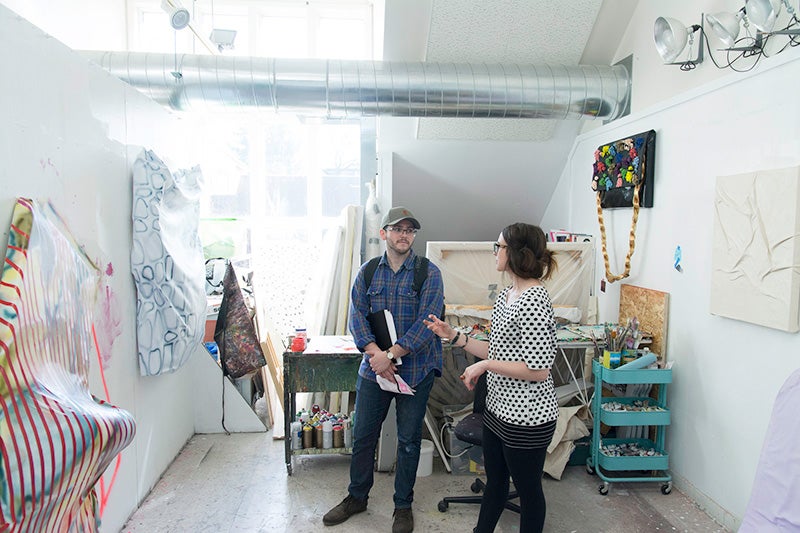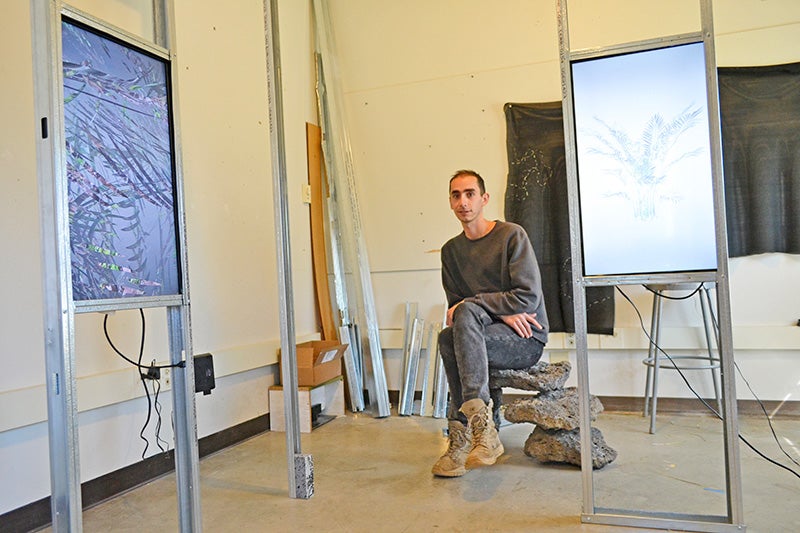The 2016 UO Art MFA Thesis Exhibition opens Friday, May 6, at Disjecta Contemporary Art Center, 8371 North Interstate Avenue in Portland, with a reception from 6-9 p.m. The exhibition runs through May 29.
The eight artists presenting work “reveal and question truths, both singular and universal, by exploring ways of being that go beyond the conventional,” states Alexandra Mickle, a UO art history graduate student, in the show catalog. “The exhibited installations are grounded in the gallery space but speak more broadly to questions of larger dialogues.”
Mickle’s commentaries about each of the artists “consider each artist both individually and as a cohort, suggesting potential threads to create discourse among distinct practices. Embracing many mediums and forms, the works in this exhibit present iterations, fragmentations, and clarifications of reality, encouraging a reevaluation of things as they are, or as they appear to be.”
Exhibiting artists are Anya Dikareva, Summer Gray, Krista Heinitz, Steven Joshlin, Daniel Lopez, Sarah Mikenis, Rachel Widomski, and Stephen Nachtigall.
“These artists have worked in tandem, occasionally collaborating, engaged in the hard work of the studio and the challenges of critical discourse,” says Christopher Michlig, graduate program director in the UO Department of Art. “Pushed by their peers, faculty members, and remarkable visitors, these artists leave the program well-equipped, with promising bodies of work and the tools for ongoing inquiry.”
Video, digital media, collage, performance, painting, sculpture, printed matter, photography, and installation make up the range of practices presented in the exhibition. “The broad range of inquiry and practice demonstrates the dynamic conceptual and formal potentials of this graduating group of young artists,” Michlig notes.

Above: Sarah Mikenis talks with digital arts undergraduate Reed Jarvis in her studio. “My paintings are sometimes stuffed and puffy, or wrinkled,” Mikenis says, “or the gesture of the painted form seems to be slumping, leaning against the wall, or bending away from the wall and toward the viewer.”
Sarah Mikenis says she tries to create art “that is unresolved or defies easy categorization. My work oscillates between being a painting and a sculpture, between being an art object and acting like an everyday object, that is simultaneously serious as well as playful and mocking.”
Her work is “more sculptural and object-like than traditional two-dimensional painting,” she says. One piece in the show is a large, green, monochromatic painting with pockets attached. Sometimes the work is easily recognizable, like a pair of pants with pockets, and other times it seems familiar, perhaps a pillowcase, a couch cushion, a tile floor, “but remains unnamable,” she says. She hopes viewers take away “some feeling of ambiguity in the work; not just that the work is indecisive, but that it swings wildly between being uneasy and completely confident.”
Her materials and processes vary widely, as has the direction of her creative inquiry since she began graduate school. Some are made in plywood covered with upholstery foam and canvas; others are made from digital drawings translated into oil or acrylic paint and airbrushed. She characterizes her show installation as a synthesis of the trajectory of her work over the past three years — from photo-realism to abstraction, from making collages to be painted, and finally to “paintings that become sculptural objects themselves.” Though her work has changed dramatically, certain themes — like the human body, fashion, consumerism, pattern, and disruption — have remained, she says.
“I am calling the installation ‘Painting’ with quotations because although I use canvas and paint, and most of the work hangs on the wall, my work is much more sculptural and object-like than traditional two-dimensional painting. My paintings are sometimes stuffed and puffy, or wrinkled, or the gesture of the painted form seems to be slumping, leaning against the wall, or bending away from the wall and toward the viewer.”

Above: Stephen Nachtigall’s installation is based around digital videos made with 3D models of plants and animation software. His work also integrates printed mesh screens and other materials as the “walls” of the space. “The result is a provisional structure that viewers can look through and also pass through physically,” he says. Photo by Marti Gerdes.
Stephen Nachtigall also departs from traditional two-dimensional work, however his installation is based around digital videos made with 3D models of plants and animation software.
The videos are shown on flatscreen televisions incorporated into a structure built with steel studs. His work also integrates printed mesh screens and other materials as the “walls” of the space. “The result is a provisional structure that viewers can look through and also pass through physically,” he says.
“I wanted the work to reflect both the physical, sculptural aspects of my work and also include digital video, which is a large part of my practice,” he says. “What I came up with is a framework that will meld these multiple ways of making together.”
Nachtigall says the work is a new direction for him at the same time “a kind of summation” of his studies at UO.
“The vibe of the work in the show will be a mix of things I see in our cultural environment, screens that are designed to shift our attention away from something or towards something else, the way that images might determine our approach to reality, and a connection to our ecological predicament that is often a tenuous mix between alienation and complacency. What I hope my work can do for viewers is to provide a place that affords the chance to reflect on how they might feel about a future where ‘nature’ might not mean anything more than an image of simulated plants on a screen.”
Disjecta is open Friday through Sunday from noon to 5 p.m. when exhibitions are staged; in between shows, the gallery is closed.
